To identify tulle, look for a lightweight, sheer fabric that feels delicate yet is surprisingly durable. It's often made from materials like silk, nylon, or polyester. You'll notice its transparent quality, making it perfect for layering in garments like bridal gowns or tutus. Tulle has a soft, airy texture and can hold its shape well, especially in costumes. Check for the various types, such as silk or nylon tulle, as each offers unique properties. Knowing these characteristics will help you spot tulle easily, and there's even more fascinating information on its use and care waiting for you.
Understanding Tulle Fabric
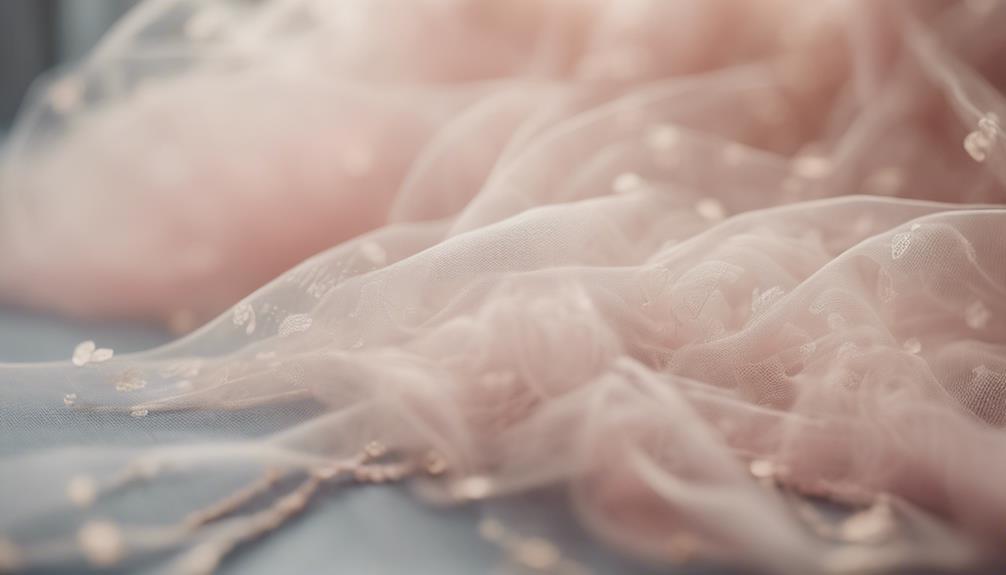
Understanding tulle fabric starts with recognizing its unique characteristics. Tulle is a lightweight, net fabric that's often sheer and delicate, making it a popular choice for various applications. Typically made from materials like silk, nylon, rayon, or polyester, tulle offers versatility in design. You'll find different types of fabrics within the tulle family, such as silk tulle and nylon tulle, each boasting unique properties.
When you explore tulle, take note of its transparent nature. This quality allows for creative layering, enhancing depth and texture in fashion, especially in bridal wear. Whether it's a wedding gown or a ballet costume, the elegance tulle adds is undeniable. Additionally, the fabric's lightweight and delicate feel contributes to its charm, making it suitable for special occasions.
Despite its delicate appearance, tulle is surprisingly durable and easy to clean. This means it can maintain its beautiful look over time, which is essential for event decorations or any item you want to keep looking fresh. By understanding these key aspects of tulle fabric, you'll be better equipped to identify and appreciate its various forms and applications.
Characteristics of Tulle
Tulle's unique characteristics make it a standout choice in the world of fabrics. Tulle is a type of delicate and lightweight material that's commonly used in fashion and decoration. Its sheer fabric gives garments a soft, airy feel, making it ideal for creating beautiful bridal gowns and elegant tutus.
One of the most appealing aspects of quality tulle is its flexibility. You can easily shape and manipulate it to create multiple layers, adding depth and dimension to your designs. Whether you're draping it over a dress or using it for event decorations, tulle's transparent nature contributes to an overall romantic aesthetic.
Despite its delicate appearance, tulle is surprisingly durable and stands up well over time, making it a practical option for various applications. This durability doesn't compromise its elegance; instead, it enhances the longevity of your creations while maintaining that light, ethereal look. To sum up, if you're looking for a fabric that combines delicacy with versatility, tulle is an excellent choice that can elevate your projects to a whole new level.
Types of Tulle Fabric
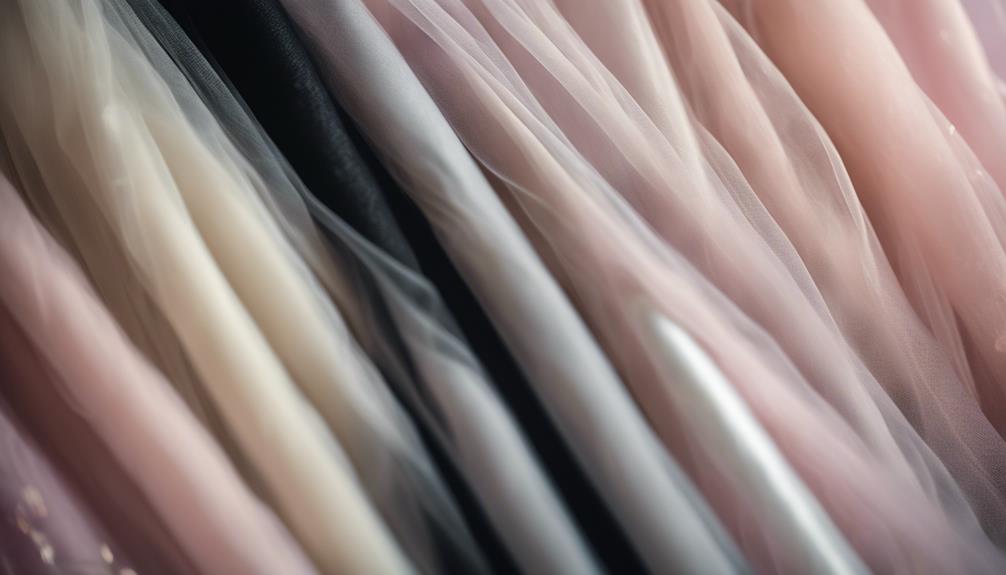
When exploring the different types of tulle fabric, you'll find that each variant brings its own unique qualities to the table. Silk tulle is perhaps the most delicate material, often chosen for high-end bridal garments and formal gowns due to its soft feel and elegant drape. If you're looking for something that holds shape well, nylon tulle is a popular choice. It's less absorbent and is frequently used in costumes and home décor projects.
For those who need durability, polyester tulle is ideal. Stronger than silk and cotton, it works well for crafting items like tutus. If you want a tulle that offers both comfort and a flattering fit, stretch tulle is your go-to. Its elastic properties make it perfect for form-fitting garments and dancewear.
Tulle in Fashion History
Tulle in Fashion History
Emerging as a staple in the fashion world, tulle fabric has a rich history that intertwines with significant moments and influential figures. It gained prominence in the 19th century, particularly after Queen Victoria wore a tulle gown for her wedding in 1840. This iconic event set a trend for bridal fashion, making tulle a popular choice for bridal veils and gowns. Its historical significance is echoed in the evolution of vintage clothing, where unique vintage clothing labels often highlight the use of tulle in various designs.
The romantic tutu, made from this lightweight and sheer, delicate fabric, was popularized by ballerina Marie Taglioni during the early 19th century, forever linking tulle to ballet and performance attire. By the 20th century, tulle became synonymous with femininity and grace, frequently showcased in haute couture collections and worn by celebrities on red carpets.
Its versatility has allowed tulle fabrics to be utilized in various fashion applications, enhancing everything from elaborate bridal veils to decorative elements in evening wear. The introduction of types like illusion tulle and glitter tulle has further cemented its place in the fashion industry, ensuring that tulle maintains its timeless elegance and relevance in contemporary design.
Common Uses for Tulle
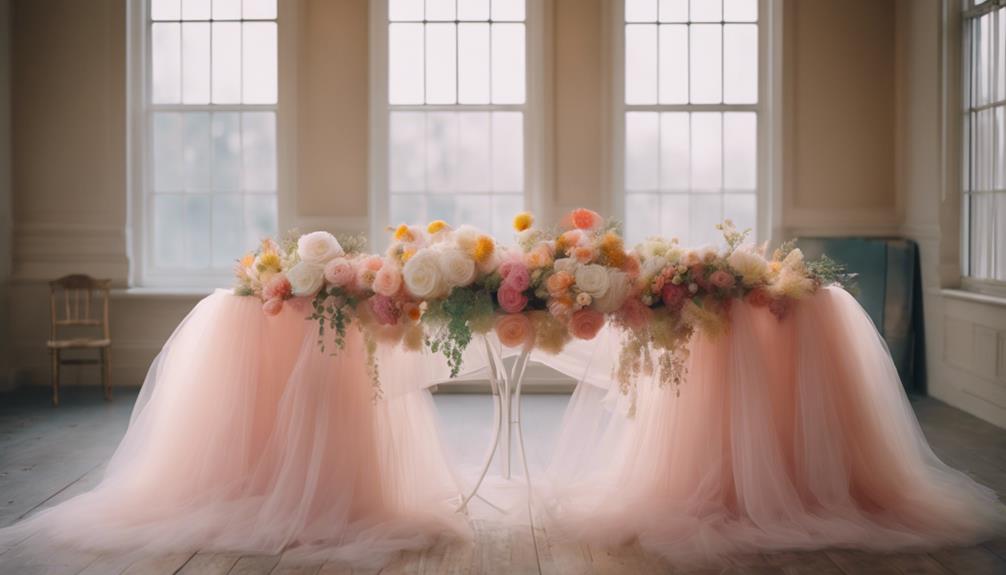
Tulle is widely celebrated for its versatility, making it a popular choice in various applications. When it comes to bridal fashion, tulle fabrics play an essential role in creating wedding veils, gowns, and other elements that add elegance to special occasions. Its lightweight and delicate nature allows brides to achieve that dreamy, ethereal look they desire on their big day.
In the domain of dance, tulle shines brightly in ballet costumes, particularly for crafting tutus and skirts that require a lightweight feel. The airy quality of this fabric type enhances movement and grace on stage, making it a staple for performers.
Tulle isn't just for clothing; it's also extensively used in event decorations. You'll find it in backdrops, table overlays, and floral arrangements, elevating the visual appeal of any venue. In fashion, tulle adds a romantic touch to party dresses and lingerie, creating a delicate aesthetic that many adore.
Its adaptability doesn't stop there—tulle is perfect for various crafting projects, including hair accessories, gift wrapping, and DIY decorations, showcasing its creative potential across numerous applications.
Caring for Tulle Fabric
Caring for tulle fabric is essential to keep its delicate beauty intact. This sheer material requires special attention to maintain its appearance and structure. Here are some key tips to guarantee your tulle stays fabulous:
- Always hand wash in cold water with a mild detergent.
- Avoid twisting or wringing; gently squeeze out excess water.
- Store tulle folded in a clean, dry place to prevent stretching.
When you hand wash tulle, use cold water and a mild detergent to protect its delicate structure. Adding a small amount of fabric softener can help maintain its softness and fresh look. After washing, remember to avoid twisting or wringing the fabric. Instead, gently squeeze out excess water and lay it flat to dry in a cool, shady area.
If you need to iron your tulle, set your iron to a low temperature. Always place a protective cloth between the iron and the tulle to prevent melting. By following these steps, you can guarantee your tulle fabric remains beautiful and ready for any occasion!
Sewing Techniques for Tulle
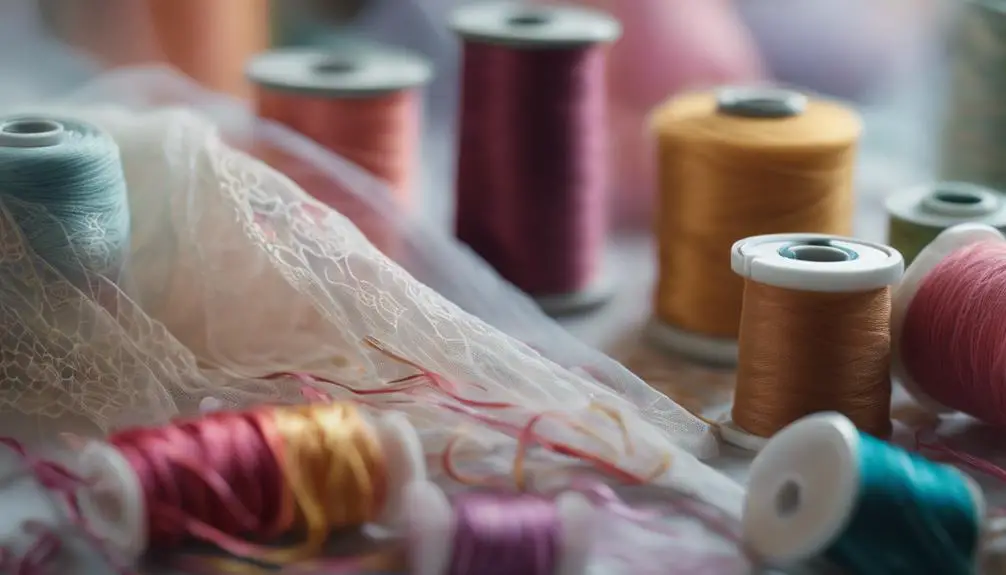
Sewing tulle can be a rewarding experience, but it requires some special techniques to handle its delicate nature. Start by using a size 9 or 11 universal needle; this helps minimize snags and guarantees a clean stitch. Opt for thin, lightweight thread, like polyester or nylon, to maintain the fabric's delicacy.
Set your sewing machine to a straight stitch with moderate tension. Before you begin, use straight pins to secure layers accurately; this will help you achieve a precise outcome. If you need added strength and want to prevent fraying, consider employing a zigzag stitch along the seams of your tulle fabric.
For projects that require extra control, hand-sewing is a great option. Use small, tight running stitches to enhance precision in your work. This technique allows you to better manage the lightweight material while making sure your stitches remain secure. By mastering these sewing techniques, you'll find that working with tulle becomes easier and more enjoyable. So, gather your tools and plunge into the delicate world of sewing tulle with confidence!
Choosing Tulle for Projects
After mastering the sewing techniques for tulle, selecting the right type for your project is equally important. The variety of tulle fabrics can greatly influence the outcome of your creations, especially when creating dresses or other delicate items. Here are a few things to take into account:
- Type of tulle: Silk tulle offers luxury for bridal projects, while polyester options are durable and versatile for crafting.
- Weight and drape: Lightweight options like illusion tulle are perfect for delicate designs, whereas stiffer tulle provides structure.
- Color and finish: Examine the color closely; glitter tulle or printed tulle can add flair, while solid colors deliver a classic look.
When choosing tulle, always check for transparency and mesh size. Finer tulle creates an ethereal effect, while coarser varieties give more support and volume. Additionally, feeling the fabric is a good idea; high-quality tulle should be soft, airy, and free from snags or rough edges. With these tips, you can make informed decisions that elevate your projects, whether they're used for bridal wear or other creative endeavors.
Where to Purchase Tulle
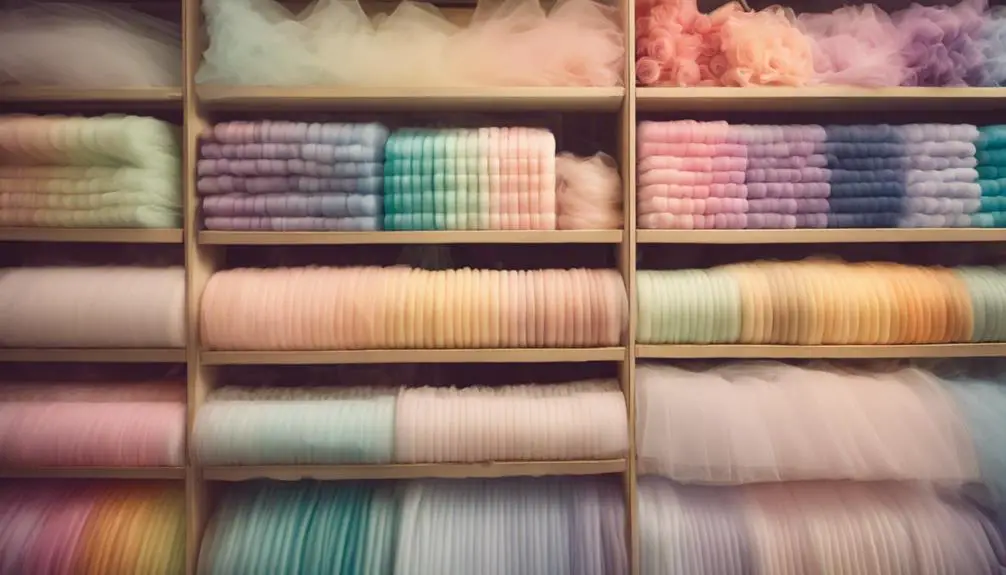
Finding the right tulle for your projects can be an exciting adventure. You've got plenty of options to explore whether you prefer local craft stores or online retailers. Local shops usually carry a variety of tulle fabrics in different colors and types, allowing you to make a selection on the spot. This is a great way to examine the quality of the material firsthand.
If you're looking for specialty options, online retailers often have a broader selection. Sites like OneYard offer tulle fabrics in various styles, including glitter and ombre, with prices ranging from $2.80 to $7 per yard. Before making a larger purchase, it's wise to order small samples to check the quality and texture of the fabric. This way, you can confirm it meets your project needs.
Additionally, if you're after higher quality tulle, consider specialty suppliers that provide luxurious French tulle known for its superior craftsmanship. By exploring these avenues, you can find the perfect tulle that fits both your style and budget. Happy tulle shopping!
Frequently Asked Questions
How to Identify Tulle Fabric?
When you're trying to identify tulle fabric, check its lightweight, sheer quality and fine mesh holes. Notice how it holds its shape while remaining flexible—these traits will help you recognize tulle effortlessly.
What Does Tulle Look Like?
Tulle looks like a delicate, airy mesh with tiny holes that let light through. It's often soft and flowy, available in various colors and finishes, making it perfect for layering in dresses or decorations.
What Is the Difference Between Tulle and Netting?
You'll notice tulle's lightweight, soft texture and smaller holes, making it ideal for delicate designs. In contrast, netting feels stiffer, has larger holes, and provides structure, perfect for evening gowns or supportive applications.
What Are the Characteristics of Tulle?
Tulle's characterized by its lightweight, net-like texture, sheer appearance, and versatility. You'll find it soft, flexible, and perfect for layering in garments or decorations. It's easy to maintain, making it a popular choice for various designs.
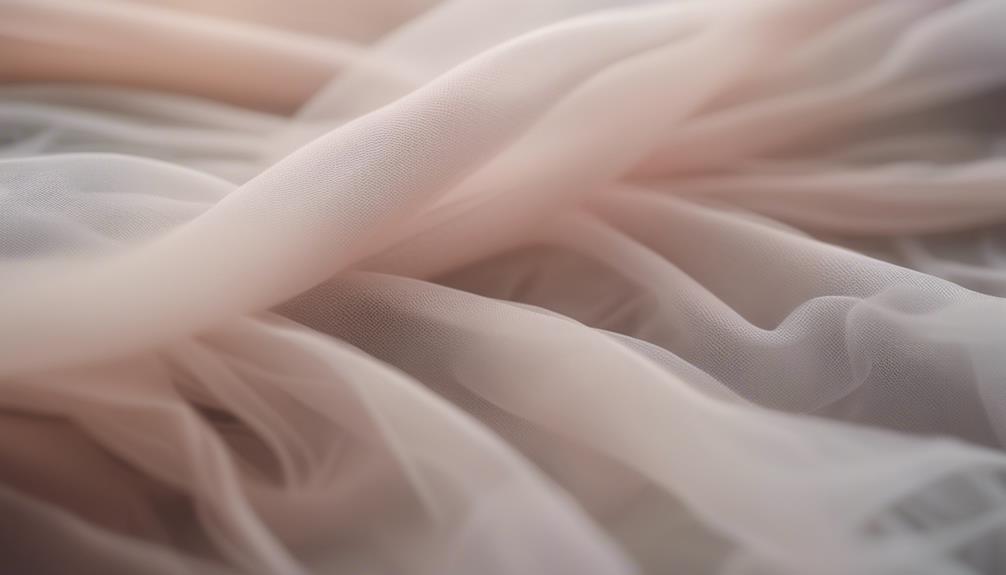



Thank you for your sharing. I am worried that I lack creative ideas. It is your article that makes me full of hope. Thank you. But, I have a question, can you help me? https://www.binance.com/pt-BR/register?ref=GJY4VW8W